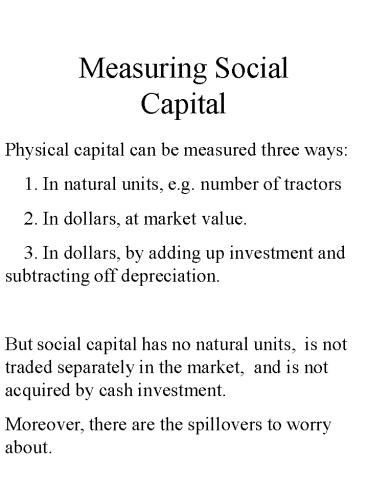Measuring Social Capital - PowerPoint PPT Presentation
1 / 16
Title:
Measuring Social Capital
Description:
Measuring Social Capital. Physical capital can be measured three ways: ... ( probit) (0.0013) (0.0153) Member of a 0.2229 0.3341. school service group? ( probit) ... – PowerPoint PPT presentation
Number of Views:62
Avg rating:3.0/5.0
Title: Measuring Social Capital
1
Measuring Social Capital
Physical capital can be measured three ways
1. In natural units, e.g. number of tractors
2. In dollars, at market value. 3. In
dollars, by adding up investment and subtracting
off depreciation. But social capital has no
natural units, is not traded separately in the
market, and is not acquired by cash investment.
Moreover, there are the spillovers to worry
about.
2
Using a Proxy
Output S2capital.3 labor .7 land2 S social
capital, unmeasureable But suppose we know that S
aB asome number, unknown Bnumber of bowling
teams Then Output (aB)2capital.3 labor .7
land2
3
Proxies for Social Capital
1. How many associations people say they belong
to (Glaeser, Putnam). 2. How much people say they
trust each other (La Porta) 3. Aggregate data
such as the number of associations in a country
or the level of crime (Putnam). 4. Subjective
evaluation by an expert observer (Fukuyama, De
Tocqueville). 5. Experimental results
(Readers Digest)
4
Surveys of Associations
The General Social Survey asked 1,500-3,000
Americans how many different kinds of
associations they belonged to, 1975-present. The
World Values Survey asked 1,000 people in each of
40 countries a similar question in 1981-4,
1990-3, and 1995-7.
5
Surveys of Trust
The World Values Survey asked Generally
speaking, would you say that most people can be
trusted, or that you can't be too careful in
dealing with people?' (But Glaeser et al.
(2000) found that Harvard students who said they
were trusting actually were not, though they were
trustworthy.)
6
Trust in Large Organizations
Rafael La Porta, Florencio Lopez-de-Silanes,
Andrei Shleifer, and Robert Vishny American
Economic Review, Papers and Proceedings, 87
333-338 (May 1997)
7
Independent Variables
- Trust in people of respondents who said most
people can be trusted when asked Generally
speaking, would you say that most people can be
trusted or that you cant be too careful in
dealing with people? - Log of Gross Domestic Product per capita
measured in dollars - Hierarchical religion of the population that
is Roman Catholic, Eastern Orthodox, or Muslim.
8
Government Variables to Explain
- Efficiency of the judiciary efficiency and
integrity of the legal environment as it affects
business, particularly foreign firms - Corruption low rating if high government
officials are likely to demand special payments
and illegal payments are generally expected
throughout lower levels of government - Bureaucratic quality autonomy from political
pressure and strength and expertise to govern
without drastic changes in policy or
interruptions in government services - Tax compliance subjective assessment of the
level
9
Civic Participation Variables
- Civic Participation of seven civic activities
in which the respondent participated, from
social-welfare services, education/art/cultural,
local community affairs, conservation/environment,
youth work, and voluntary health organizations - Participation in professional associations of
respondents who belonged to one
10
Social Efficiency Variables
- Infrastructure quality Subjective assessment of
the facilities for and ease of communication
between headquarters and the operation, and
within the country and of transportation - Adequacy of infrastructure Average of five
scores of the extent to which business needs are
met by roads, air, ports, telecommunications and
power supply. - Log of the infant mortality rate Deaths before
age one per thousand live births - Completed high school for the male population
aged 25 and over - Adequacy of educational system the extent to
which education meets the needs of a competitive
economy - Log inflation log of the geometric average
annual inflation using the implicit price
deflator for GDP - GDP growth average annual growth in per capita
GDP
11
Family vs. Strangers
- When the ratio of the Top 20 firms sales to GDP
is regressed on Trust and on Trust in Family, the
coefficient on Trust is .65 (t4.1) and the
coefficient on Trust in Family is -.56 (t3.1). - So is Trust in Family bad for big companies?
12
New LaPorta Regressions
R-squared 0.69
-------------------------------------------------
--------- Judicial Efficiency Coefficient
t-statistic Conf. ------------------------------
------------------- ------- log GNP
.33 1.42 Hierarch.Religion
-.006 -0.75 Trust
7.07 2.75 1.2
Trust in Family -1.39 -0.74
Constant 8.01 1.07
R-squared 0.50
-------------------------------------------------
------------ Civic Participation
Coefficient t-statistic Conf.
-------------------------------------------------
--------- log GNP .012
2.45 2.1 Hierarch.Religion
-.0001 -0.89 Trust
.097 1.83 7.9 Trust
in Family -.0035 -0.17
Constant -.052
-0.59 The percentages are the levels of
confidence that the effect is not zero.
13
Conclusions--Laporta
- The Trust variable is correlated across
countries with many indicators of success. - Membership in associations is also correlated
with success. - Religion probably does not have an effect on
success besides its effect on Trust, but it may
have a big effect on Trust.
14
Table 4 Memberships
Dependent Variable, dy/dx
dy/dx y x Education
x Home
Ownership Total number of
0.2229 0.3341
memberships (OLS) (0.0046)
(0.0590) Member of a
0.0260
0.0562 church group? (probit)
(0.0013) (0.0153) Member of
a 0.2229
0.3341 school service group?
(probit) (0.0046)
(0.0590) Includes controls for log(income),
income missing, black,female, year of birth, age
category, married, number of children, region,
and log city population. The number of
observations is about 18,500 for the Education
regressions and 5,700 for the Home regressions.
15
Conclusions--Glaeser
- People do tend to choose their memberships in
associations as if they were investments. - Middle-aged, rich, non-mobile people, and
especially, educated ones, join the most
associations. - Most of the variance in joining is left
unexplained, though.
16
(No Transcript)































